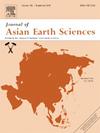Petrogenesis of the early-middle Paleozoic granites in northern Wuyi, South China: Implications for the geodynamic process of the Wuyi-Yunkai orogen
IF 2.7
3区 地球科学
Q2 GEOSCIENCES, MULTIDISCIPLINARY
引用次数: 0
Abstract
The Early Paleozoic igneous rocks are extensively distributed across the Cathaysia Block, documenting the Wuyi-Yunkai orogeny in South China. However, the detailed geodynamic process of this orogen remains unclear. To elucidate this tectonic history, we conducted an in-depth investigation of two significant granitic plutons in northern Wuyi. LA-ICP-MS zircon U-Pb dating reveals that the Huangdun pluton was emplaced during the early Silurian (435 – 434 Ma), whereas the Jiaoxi pluton was formed during the early Devonian (401 – 398 Ma). The Huangdun monzogranites characterized by high silica content, predominantly metaluminous to peraluminous nature, low FeOT/MgO ratios (2.21 – 2.83) and normative-CIPW corundum values (C = 0.48 – 4.72 wt%), closely resembling I–S transformation-type granites. They show relatively low initial 87Sr/86Sr ratios (0.7053 – 0.7077), εNd(t) values (−6.6 to − 6.2), and zircon εHf(t) values (−6.6 to − 0.6). These geochemical and isotopic signatures suggest that these granites were formed through partial melting of metasedimentary and meta-mafic rocks. In contrast, the Jiaoxi two-mica granites are rich in silica, peraluminous, with elevated FeOT/MgO ratios (3.94 – 4.98) and high differentiation index values (88.6 – 93.4), indicating their classification as fractionated S-type granites. They display variable εHf(t) values (−15.1 to + 0.6) and low εNd(t) values (−7.0 to − 5.9). These features suggest that they were derived from partial melting of metasedimentary rocks. Integrating these findings with previous research, including the presence of Early Paleozoic MOR-type ophiolites, we propose that the Wuyi-Yunkai orogen as a subduction-collisional orogen. The Huangdun granites were formed during the syn-collisional stage in the early Silurian, while the Jiaoxi granites were generated during the post-collisional extension stage in the early Devonian.

武夷北部早-中古生代花岗岩成因及其对武夷-云开造山带地球动力学过程的启示
华夏地块广泛分布早古生代火成岩,记录了华南武夷—云开造山运动。然而,该造山带的详细地球动力学过程尚不清楚。为了阐明这一构造史,我们对武夷北部两个重要的花岗质岩体进行了深入调查。LA-ICP-MS锆石U-Pb定年结果表明,黄墩岩体形成于早志留世(435 ~ 434 Ma),而胶西岩体形成于早泥盆世(401 ~ 398 Ma)。黄墩二长花岗岩具有高硅含量、低FeOT/MgO比值(2.21 ~ 2.83)和低cipw刚玉值(C = 0.48 ~ 4.72 wt%),与I-S转化型花岗岩相似的特征。它们具有较低的初始87Sr/86Sr比值(0.7053 ~ 0.7077)、εNd(t)值(- 6.6 ~ - 6.2)和锆石εHf(t)值(- 6.6 ~ - 0.6)。这些地球化学和同位素特征表明,这些花岗岩是由变质沉积岩和变质基性岩的部分熔融作用形成的。胶西二云母花岗岩富硅质、过铝质,FeOT/MgO比值较高(3.94 ~ 4.98),分异指标值较高(88.6 ~ 93.4),属于分选s型花岗岩。εHf(t)值变化(- 15.1 ~ + 0.6),εNd(t)值变化(- 7.0 ~ - 5.9)。这些特征表明它们是由变质沉积岩部分熔融形成的。结合前人的研究成果,包括早古生代摩尔型蛇绿岩的存在,我们认为武夷-云开造山带为俯冲-碰撞造山带。黄墩花岗岩形成于早志留世同碰撞期,胶西花岗岩形成于早泥盆世碰撞后伸展期。
本文章由计算机程序翻译,如有差异,请以英文原文为准。
求助全文
约1分钟内获得全文
求助全文
来源期刊

Journal of Asian Earth Sciences
地学-地球科学综合
CiteScore
5.90
自引率
10.00%
发文量
324
审稿时长
71 days
期刊介绍:
Journal of Asian Earth Sciences has an open access mirror journal Journal of Asian Earth Sciences: X, sharing the same aims and scope, editorial team, submission system and rigorous peer review.
The Journal of Asian Earth Sciences is an international interdisciplinary journal devoted to all aspects of research related to the solid Earth Sciences of Asia. The Journal publishes high quality, peer-reviewed scientific papers on the regional geology, tectonics, geochemistry and geophysics of Asia. It will be devoted primarily to research papers but short communications relating to new developments of broad interest, reviews and book reviews will also be included. Papers must have international appeal and should present work of more than local significance.
The scope includes deep processes of the Asian continent and its adjacent oceans; seismology and earthquakes; orogeny, magmatism, metamorphism and volcanism; growth, deformation and destruction of the Asian crust; crust-mantle interaction; evolution of life (early life, biostratigraphy, biogeography and mass-extinction); fluids, fluxes and reservoirs of mineral and energy resources; surface processes (weathering, erosion, transport and deposition of sediments) and resulting geomorphology; and the response of the Earth to global climate change as viewed within the Asian continent and surrounding oceans.
 求助内容:
求助内容: 应助结果提醒方式:
应助结果提醒方式:


